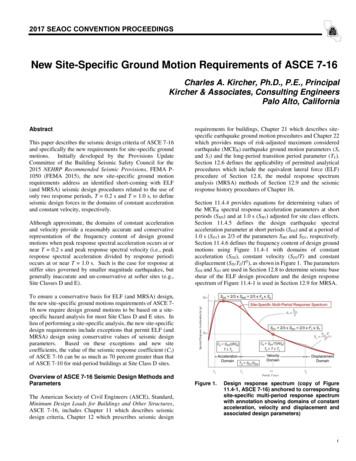Building Block ASCE 24 Construction Standards
BUILDING BLOCKSDRAFTEFFECTIVE DATE:TBDSUBJECT:To establish compliance with the construction ofbuildings and structures governed by the FloridaBuilding Code (FBC) 5th Edition – Building and ASCE24-14 - Flood Resistant Design and Construction.AUTHORITY:FBC 5th Edition: Chapter 1 – Administration, 101.2Scope; Section 1612 Flood Loads; 1612.4 Design andconstruction; Chapter 5 of ASCE 7 – Wind Load andASCE 24 – Flood Resistant Design and Construction;Collier County Flood Damage Prevention OrdinancePURPOSE:To establish that compliance with Chapter 5 of ASCE 7and ASCE 24-14 is required for buildings andstructures located in flood hazard areas, includingcoastal high hazard areas.RELATED BUILDING BLOCKS: A-128 Certified Site Plans and Spot Surveysand A-132 FEMA InspectionsDEFINITIONS:Base Flood Elevation (BFE): The BFE is the elevation of flooding, including waveheight, having the 1% chance of being equaled or exceeded in any given year. TheBFE is identified on Collier County’s effective Digital Flood Insurance Rate Map(DFIRM).Design Flood Elevation (DFE): The elevation of the “design flood,” including waveheight, relative to the datum specified on the community’s legally designated floodhazard map.In general, the BFE and the DFE are the same elevation on the Collier Countyeffective DFIRM.For the purposes of South Florida Water Management District (SFWMD) DFEs, theSFWMD DFE will be compared to the BFE 1, and the higher elevation will berequired.A-XX Compliance with ASCE 24-14 for BuildingsJuly 27, 2015Page 1 of 7
Dry floodproofing: A combination of design modifications that results in a buildingor structure, including the attendant utilities and equipment and sanitary facilities,being water tight with walls substantially impermeable to the passage of waterand with structural components having the capacity to resist loads as identified inASCE 7 (Section 1612 FBC).Flood Hazard Area: The greater of the following two areas: 1) The area within afloodplain subject to a 1-percent of greater chance of flooding in any given year.2) The area designated as a flood hazard area on a community’s flood hazardmap, or otherwise legally designated.For the purposes of this Building Block, the Flood Hazard Area in Collier Countyshall include any flood zone that begins with a “V” or “A”.PERMITS:The FBC Building establishes in Chapter 1 – Administrative the scope theBuilding code and reads as follows:101.2 Scope. The provisions of this code shall apply to the construction,alteration, relocation, enlargement, replacement, repair, equipment, use andoccupancy, location, maintenance, removal and demolition of every building ofstructure or any appurtenances connected or attached to such buildings orstructures.Exceptions:1. Detached one- and two-family dwellings and multiple single familydwellings (town houses) not more than three stories above grade planein height with a separate means of egress and their accessorystructures shall comply with the Florida Building Code, Residential.2. Existing buildings undergoing repair, alterations or additions or changeof occupancy shall comply with Chapter 34 of this code.Section 1612 Flood Loads establishes General and Design and constructionstandards as follows:1612.1 General. Within flood hazard areas as established in Section 1612.3, allnew construction of buildings, structures and portions of buildings and structures,including substantial improvement and restoration of substantial damage tobuildings and structures, shall be designed and constructed to resist the effectsof flood hazards and flood loads. For buildings that are located in more than oneflood hazard area, the provisions associated with the most restrictive floodhazard area shall apply.A-XX Compliance with ASCE 24-14 for BuildingsJuly 27, 2015Page 2 of 7
1612.4 Design and construction. The design and construction of buildings andstructures located in flood hazard areas, including coastal high hazard areas,shall be in accordance with C
A-XX Compliance with ASCE 24-14 for Buildings July 27, 2015 Page 3 of 7 1612.4 Design and construction. The design and construction of buildings and structures located in flood hazard areas, including coastal high hazard areas, shall be in accordance with Chapter 5 of ASCE 7 and ASCE 24. 161
NCS eNewsletter Archives: go to www.asce-ncs.org and view along the sidebar. Address Changes: Call 1-800-548-ASCE, e-mail member@asce.org, visit www.asce.org, or write: ASCE - Membership, 1801 Alexander Bell Drive, Reston, VA 20191. Include your membership number. Newsletter Officers (2020-2021) Mike Venezia, President
Building Code Requirements for Masonry Structures (ACI 530-02/ASCE 5-02/TMS 402-02) and Specifi cations for Masonry Structures (ACI 530.1-02/ASCE 6-02/TMS . ASCE/EWRI 40-03 Regulated Riparian Model Water Code ASCE/SEI 41-06 Seismic Rehabilitation of Existing Buildings ASCE/EWRI 42-04 Standard Practice for the Design and Opera-
BACKGROUND ON ASCE 41 ASCE 41-13 is an update and combination of the ASCE 41-06 and ASCE 31-03 stan-dards, which are intended for the seismic evaluation and retrofit of existing buildings. ASCE 41-13 establishes tables of accepta
of ASCE 7-10 for mid-period buildings at Site Class D sites. Overview of ASCE 7-16 Seismic Design Methods and Parameters . 11.4-1, ASCE 7-The American Society of Civil Engineers (ASCE), Standard, Minimum Design Loads for Buildings and Other Structures, ASCE 7-16, inc
This document, also available on the ASCE Student Conferences page of the ASCE Website, defines the 2022 ASCE Innovation Contest and the rules for both the student symposium and Society-wide finals competition levels. Requests for Information (RFI) should be sent to student@asce.org with the subject line "ASCE Innovation Contest RFI."
Briefing on the Effort to Update ASCE 31 and 41 Slide 1 Proposed Updates to ASCE 31 and 41 A Mid -cycle Snapshot Update for the BSSC PUC December 7, 2010 Washington, DC Bob Pekelnicky Vice - Chair and Secretariat Slide 2 ASCE 31 -03 Seismic Evaluation of Existing Buildings ASCE 41 - 06 Supplement No. 1 Seismic Rehabiliation of Existing Buildings
Chapter 5 of ASCE 7 and ASCE 24. FEMA deems ASCE 24 to meet or exceed the minimum National Flood Insurance Program (NFIP) requirements for buildings and structures. The 2015 I-Codes reference ASCE 24 -14, while the 2006 through 2012 I-Codes reference ASCE 24 -05. A summary of significant technical revisions from
If you are starting on Advanced Level, we advise that you enrol onto the EIMF 2 Day Bookkeeping course, as there is an assumption at this level that you have a good knowledge of Double Entry Bookkeeping. Syllabus You will learn complex accounting techniques including maintaining cost accounting records and the preparation of reports and returns .























